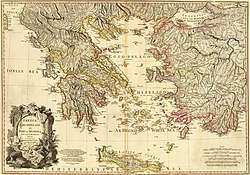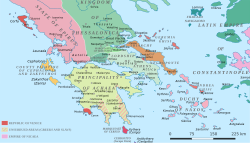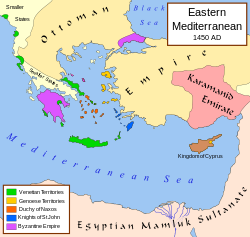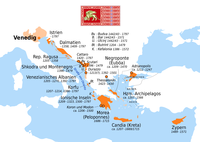Frankokratia
This articleneeds additional citations forverification.(February 2019) |
| History ofGreece |
|---|
 |
|
|



TheFrankokratia(Greek:Φραγκοκρατία,Latin:Francocratia,sometimesanglicizedasFrancocracy,lit. 'rule of theFranks'), also known asLatinokratia(Greek:Λατινοκρατία,Latin:Latinocratia,"rule of theLatins",Latin occupation) and, for theVenetiandomains,VenetokratiaorEnetokratia(Greek:Βενετοκρατία or Ενετοκρατία,Latin:Venetocratia,"rule of the Venetians" ), was the period inGreek historyafter theFourth Crusade(1204), when a number of primarily French and Italian states were established by thePartitio terrarum imperii Romaniaeon the territory of the dismantledByzantine Empire.
The terms Frankokratia and Latinokratia derive from the name given by theOrthodoxGreeks to theWesternFrench and Italians who originated from territories that once belonged to theFrankish Empire,as this was the political entity that ruled much of the formerWestern Roman Empireafter the collapse of Roman authority and power. The span of theFrankokratiaperiod differs by region: the political situation proved highly volatile, as the Frankish states fragmented and changed hands, and the Greek successor states re-conquered many areas.
With the exception of theIonian Islandsand some islands or forts whichremained in Venetian handsuntil the turn of the 19th century, the end of theFrankokratiain most Greek lands came with theOttoman conquest,chiefly in the 14th to 17th centuries, which ushered in the period known as "Tourkokratia"(" rule of the Turks "; seeOttoman Greece).
Latin states
[edit]Latin Empire
[edit]TheLatin Empire(1204–1261), centered inConstantinopleand encompassingThraceandBithynia,was created as the successor of the Byzantine Empire after the Fourth Crusade, while also exercising nominal suzerainty over the other Crusader principalities. Its territories were gradually reduced to little more than the capital, which was eventuallycapturedby theEmpire of Nicaeaunder the rule ofMichael VIII Palaiologosin 1261.
- Duchy of Philippopolis(1204 – after 1230), a fief of theLatin Empirein northern Thrace, until its capture by theBulgarians.
- Lemnosformed a fief of the Latin Empire under the Venetian Navigajoso family from 1207 until conquered by the Byzantines in 1278. Its rulers bore the title ofmegadux( "grand duke" ) of the Latin Empire.
- TheKingdom of Thessalonica(1205–1224), encompassingMacedoniaandThessaly.The brief existence of the Kingdom was almost continuously troubled by warfare with theSecond Bulgarian Empire;eventually, it was conquered by theDespotate of Epirus.
- TheCounty of Salona(1205–1410), centred at Salona (modernAmfissa), like Bodonitsa, was formed as a vassal state of the Kingdom of Thessalonica and later came under the influence of Achaea. It came under Catalan and later Navarrese[citation needed]rule in the 14th century, before being sold to theKnights Hospitallerin 1403. It was finally conquered by the Ottomans in 1410.
- TheMarquisate of Bodonitsa(1204–1414), like Salona, was originally created as a vassal state of the Kingdom of Thessalonica but later came under the influence of Achaea. In 1335, the Venetian Giorgi family took control and ruled until the Ottoman conquest in 1414.
- ThePrincipality of Achaea(1205–1432), encompassing theMoreaorPeloponnesepeninsula. It quickly emerged as the strongest state and prospered even after the demise of the Latin Empire. Its main rival was the ByzantineDespotate of the Morea,which eventually succeeded in conquering the Principality. It also exercised suzerainty over theLordship of Argos and Nauplia(1205–1388).
- TheDuchy of Athens(1205–1458), with its two capitalsThebesandAthens,and encompassingAttica,Boeotia,and parts of southernThessaly.In 1311, the Duchy wasconqueredby theCatalan Company,and in 1388, it passed into the hands of theFlorentineAcciaiuoli family, which kept it until the Ottoman conquest in 1456.
- TheDuchy of Naxosor of the Archipelago (1207–1579), founded by theSanudofamily, it encompassed most of theCyclades.In 1383, it passed under the control of the Crispo family. The Duchy became an Ottoman vassal in 1537 and was finally annexed to the Ottoman Empire in 1579.
- TheTriarchy of Negroponte(1205–1470), encompassing the island of Negroponte (Euboea), originally a vassal of Thessalonica, then of Achaea. It was fragmented into three baronies (terzior "triarchies" ) run each by two barons (thesestieri). This fragmentation enabledVeniceto gain influence by acting as mediators. By 1390 Venice had established direct control of the entire island, which remained in Venetian hands until 1470, when it wascapturedby the Ottomans.
Minor Crusader principalities
[edit]- TheCounty palatine of Cephalonia and Zakynthos(1185–1479). It encompassed theIonian IslandsofCephalonia,Zakynthos,Ithaca,and, from around 1300, alsoLefkas(Santa Maura). Created as a vassal to theKingdom of Sicily,it was ruled by theOrsini familyfrom 1195 to 1335, and after a short interlude ofAnjourule the county passed to theTocco familyin 1357. The county was split between Venice and the Ottomans in 1479.
- Rhodesbecamethe headquarters of the military monastic order of theKnights Hospitallerof Saint John in 1310, and the Knights retained control of the island (and neighbouring islands of theDodecaneseisland group) untilousted by the Ottomans in 1522.
Genoese colonies
[edit]Genoeseattempts to occupy Corfu and Crete in the aftermath of the Fourth Crusade were thwarted by the Venetians. It was only during the 14th century, exploiting the terminal decline of theByzantine Empire under the Palaiologos dynasty,and often in agreement with the weakened Byzantine rulers, that various Genoese nobles established domains in the northeastern Aegean:
- TheGattilusifamily established a number of fiefs, under nominal Byzantine suzerainty, over the island ofLesbos(1355–1462) and later also the islands ofLemnos,Thasos(1414–1462) andSamothrace(1355–1457), as well as theThraciantown ofAinos(1376–1456).
- TheLordship of Chioswith the port ofPhocaea.In 1304–1330 under theZaccariafamily, and, after a Byzantine interlude, from 1346 and until the Ottoman conquest in 1566 under theMaona di Chio e di Foceacompany.
Venetian colonies
[edit]TheRepublic of Veniceaccumulated several possessions in Greece, which formed part of itsStato da Màr.Some of them survived until thefall of the Republicitself in 1797:
- Crete,also known as Candia, (1211–1669),[1]one of the Republic's most important overseas possessions, despite frequent revolts by the Greek population, it was retained until captured by the Ottomans in theCretan War.[2]
- Corfu(1207–1214 and 1386–1797), was captured by Venice from its Genoese ruler shortly after theFourth Crusade.The island was soon retaken by theDespotate of Epirusbut captured in 1258 by theKingdom of Sicily.The island remained under Angevin rule until 1386 when Venice reimposed its control, which would last until the end of the Republic itself.
- Lefkas(1684–1797), originally part of the Palatine county and the Orsini-ruled Despotate of Epirus, it came under Ottoman rule in 1479, and was conquered by the Venetians in 1684, during theMorean War.
- Zakynthos(1479–1797), originally part of the Palatine county and the Orsini-ruled Despotate of Epirus, it fell to Venice in 1479
- CephaloniaandIthaca(1500–1797), originally part of the Palatine county and the Orsini-ruled Despotate of Epirus, they came under Ottoman rule in 1479 and wereconqueredby the Venetians in December 1500.[3]
- TinosandMykonos,bequeathed to Venice in 1390.[4]
- various coastal fortresses in thePeloponneseand mainland Greece:
- Modon (Methoni) and Coron (Koroni), occupied in 1207, confirmed by theTreaty of Sapienza,[5]and held untiltakenby the Ottomans in August 1500.[6]
- Nauplia(Italian Napoli di Romania), acquired through the purchase of the lordship ofArgos and Naupliain 1388,[7]held until captured by the Ottomans in 1540.[8]
- Argos,acquired through the purchase of the lordship ofArgos and Naupliabut seized by theDespotate of the Moreaand not handed over to Venice until June 1394,[7]held until captured by the Ottomans in 1462.[9]
- Athens,acquired in 1394 from the heirs ofNerio I Acciaioli,but lost to the latter's bastard sonAntonioin 1402–03, a fact recognized by the Republic in a treaty in 1405.[10]
- Parga,port town on the coast of Epirus, acquired in 1401. It was governed as a dependency of Corfu, and remained so even after the end of the Venetian Republic in 1797, finally being ceded by the British toAli Pashain 1819.[4]
- Lepanto (Naupaktos), a port inAetolia,briefly seized by a Venetian captain in 1390, in 1394 its inhabitants offered to hand it over to Venice, but were rebuffed. Finally sold to Venice in 1407 by its Albanian ruler,Paul Spata,[11][12]lost to the Ottomans in 1540.[8]
- Patras,held in 1408–13 and 1417–19 in lease, for 1,000 ducats per year, from theLatin Archbishop of Patras,who thus hoped to thwart a Turkish or Byzantine takeover of the city.[13][14]
- TheNorthern Sporades(Skiathos,Skopelos,andAlonissos), were Byzantine possessions that came under Venetian rule after the Fall of Constantinople in 1453. They were captured by the Ottomans underHayreddin Barbarossain 1538.
- Monemvasia(Malvasia), a Byzantine outpost left unconquered by the Ottomans in 1460, it accepted Venetian rule, until captured by the Ottomans in 1540.[15]
- Vonitsaon the coast of Epirus, captured in 1684 and held as a mainland exclave of the Ionian Islands until the end of the Republic.
- Prevezaon the coast of Epirus, occupied during theMorean War(1684–99), recaptured in 1717 and held as a mainland exclave of the Ionian Islands until the end of the Republic.
- The whole of the Peloponnese orMoreapeninsula was conquered during theMorean Warin the 1680s and became a colony as the "Kingdom of the Morea",but it waslostagain to the Ottomans in 1715.
Gallery
[edit]-
TheFrankish toweron theAcropolis of Athens,demolished in 1874
-
Chlemoutsicastle
-
Rhodes (city),around 1490
-
Church of Virgin,Rhodes (city)
-
GenoeseCastle of Mytilene
Venetian possessions (till 1797):
-
Map of theKingdom of Candia
-
Venetian map of Negroponte (Chalkis)
-
Fortress ofNafpaktos
-
Rocca a Marefortress inHeraklion
-
The Morosini fountain,Lions Square,Heraklion
See also
[edit]References
[edit]- ^Maltezou,Crete during the Period of Venetian Rule,p. 105
- ^Maltezou,Crete during the Period of Venetian Rule,p. 157
- ^Setton 1978,pp. 98, 290, 522–523.
- ^abMiller 1908,p. 365.
- ^Bon 1969,p. 66.
- ^Setton 1978,pp. 515–522.
- ^abTopping 1975,pp. 153–155.
- ^abFine 1994,p. 568.
- ^Fine 1994,p. 567.
- ^Miller 1908,pp. 354–362.
- ^Fine 1994,pp. 356, 544.
- ^Miller 1908,p. 363.
- ^Topping 1975,pp. 161–163.
- ^Miller 1908,pp. 353–364.
- ^Fine 1994,pp. 567–568.
Sources
[edit]- Bintliff, John (2012)."The Archaeology of Frankish-Crusader Society in Greece".The Complete Archaeology of Greece: From Hunter-Gatherers to the 20th Century A.D.John Wiley & Sons. pp. 416–435.ISBN978-1405154192.
- Bon, Antoine (1969).La Morée franque. Recherches historiques, topographiques et archéologiques sur la principauté d'Achaïe[The Frankish Morea. Historical, Topographic and Archaeological Studies on the Principality of Achaea] (in French). Paris: De Boccard.OCLC869621129.
- Fine, John V. A. Jr.(1994) [1987].The Late Medieval Balkans: A Critical Survey from the Late Twelfth Century to the Ottoman Conquest.Ann Arbor, Michigan: University of Michigan Press.ISBN0-472-08260-4.
- Geanakoplos, Deno John(1959).Emperor Michael Palaeologus and the West, 1258–1282: A Study in Byzantine-Latin Relations.Cambridge, Massachusetts: Harvard University Press.OCLC1011763434.
- Jacobi, David (1999). "The Latin empire of Constantinople and the Frankish states in Greece". InAbulafia, David(ed.).The New Cambridge Medieval History, Volume 5, c.1198–c.1300.Cambridge: Cambridge University Press. pp. 525–542.ISBN978-1-13905573-4.
- Longnon, Jean (1969) [1962]."The Frankish States in Greece, 1204–1311".InSetton, Kenneth M.;Wolff, Robert Lee;Hazard, Harry W. (eds.).A History of the Crusades, Volume II: The Later Crusades, 1189–1311(Second ed.). Madison, Milwaukee, and London: University of Wisconsin Press. pp. 234–275.ISBN0-299-04844-6.
- Maltezou, Chrysa A. (1988). "Η Κρήτη στη Διάρκεια της Περίοδου της Βενετοκρατίας (" Crete during the Period of Venetian Rule (1211–1669) ")". In Panagiotakis, Nikolaos M. (ed.).Crete, History and Civilization(in Greek). Vol. II. Vikelea Library, Association of Regional Associations of Regional Municipalities. pp. 105–162.
- Miller, William(1908).The Latins in the Levant: A History of Frankish Greece (1204–1566).London: John Murray.OCLC563022439.
- Miller, William(1921).Essays on the Latin Orient.Cambridge: Cambridge University Press.OCLC457893641.
- Nicol, Donald M.(1984) [1957].The Despotate of Epiros 1267-1479: A Contribution to the History of Greece in the Middle Ages(2. expanded ed.). Cambridge University Press.ISBN9780521261906.
- Nicol, Donald M.(1993).The Last Centuries of Byzantium, 1261–1453(Second ed.). Cambridge: Cambridge University Press.ISBN978-0-521-43991-6.
- Setton, Kenneth M.(1976).The Papacy and the Levant (1204–1571), Volume I: The Thirteenth and Fourteenth Centuries.Philadelphia: The American Philosophical Society.ISBN0-87169-114-0.
- Setton, Kenneth M.(1978).The Papacy and the Levant (1204–1571), Volume II: The Fifteenth Century.Philadelphia: The American Philosophical Society.ISBN0-87169-127-2.
- Topping, Peter (1975)."The Morea, 1311–1364".InSetton, Kenneth M.;Hazard, Harry W. (eds.).A History of the Crusades, Volume III: The Fourteenth and Fifteenth Centuries.Madison and London: University of Wisconsin Press. pp. 104–140.ISBN0-299-06670-3.
- Topping, Peter (1975)."The Morea, 1364–1460".InSetton, Kenneth M.;Hazard, Harry W. (eds.).A History of the Crusades, Volume III: The Fourteenth and Fifteenth Centuries.Madison and London: University of Wisconsin Press. pp. 141–166.ISBN0-299-06670-3.
- Zachariadou, Elisabeth (1980). "The Turks and the Venetian Territories in Romania (1318-1407)".Πεπραγμένα του Δ' Διεθνούς Κρητολογικού Συνεδρίου, Ηράκλειο, 29 Αυγούστου - 3 Δεκεμβρίου 1976. Τόμος Β′ Βυζαντινοί και μέσοι χρόνοι.Athens: University of Crete. pp. 103–122.
- Zečević, Nada (2014).The Tocco of the Greek Realm: Nobility, Power and Migration in Latin Greece (14th-15th centuries).Belgrade: Makart.ISBN9788691944100.
External links
[edit]





















